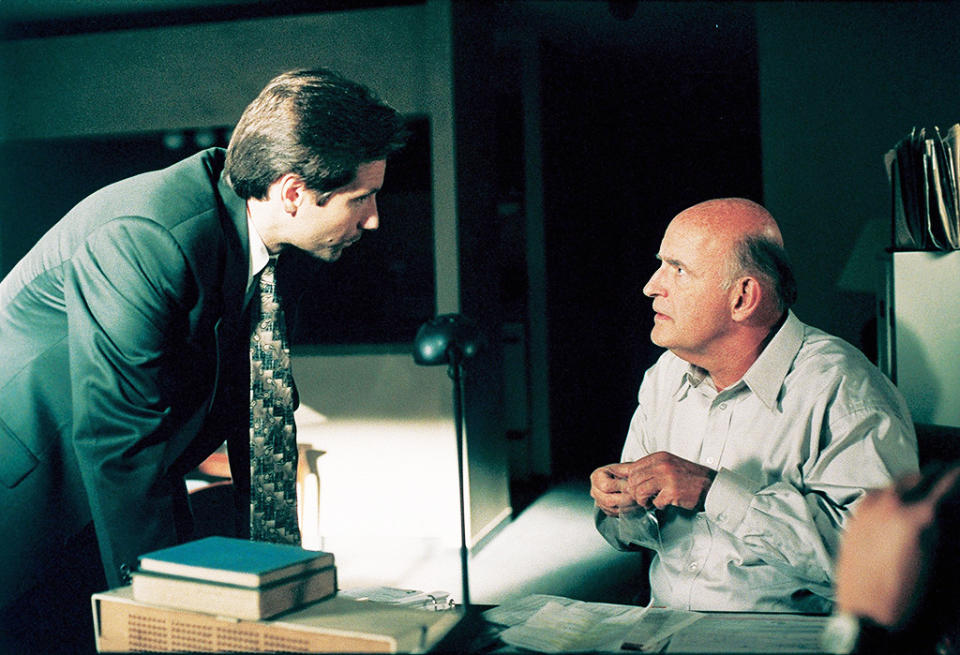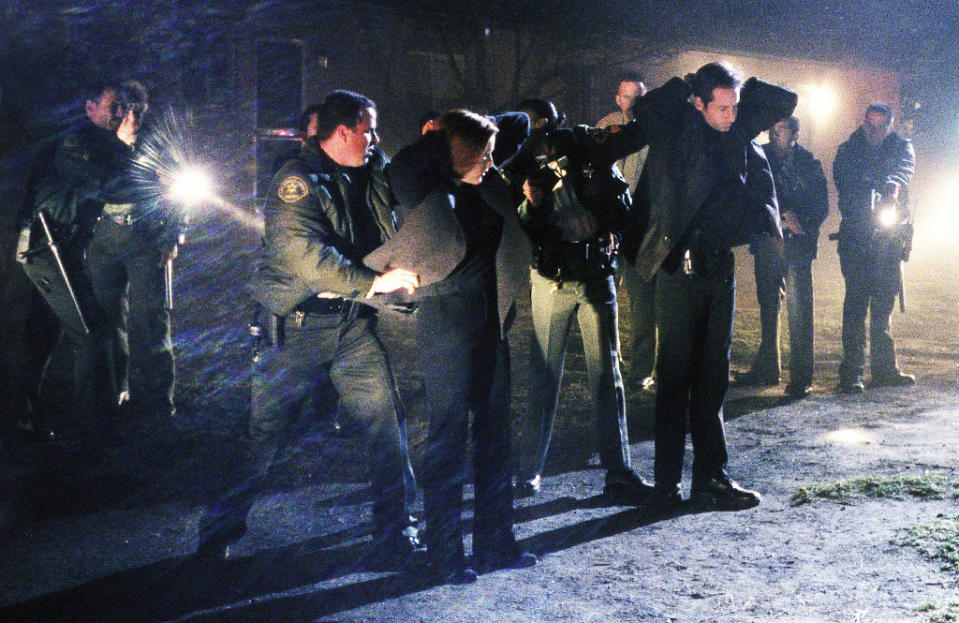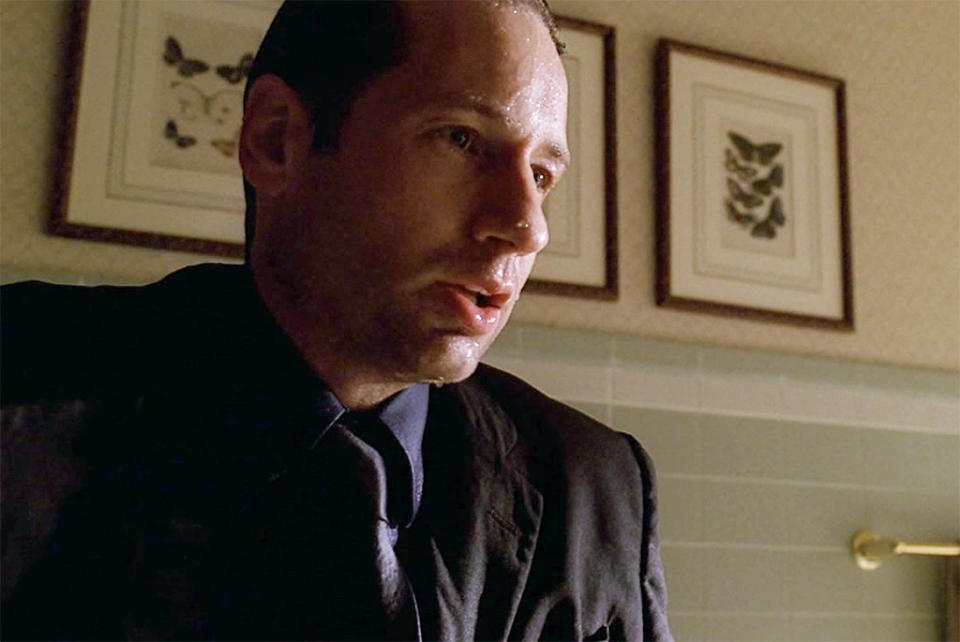'The X-Files' at 25: The 25 greatest monster-of-the-week episodes

The truth can be told: The X-Files premiered 25 years ago today — Sept. 10, 1993 — and introduced the world to paranormal investigators Fox Mulder (David Duchovny) and Dana Scully (Gillian Anderson). The show’s first season also started its complex (or, if you prefer, convoluted) mythology involving black oil, super soldiers, and an always-looming alien invasion. But the show’s finest hours tended to be standalone stories, which involved creepy monsters of the week rather than an unwieldy “mytharc.” For the show’s quarter-century anniversary, we’re spotlighting its 25 best self-contained cases. Want to believe The X-Files was great, despite its messy final years? Binge on these episodes, all of which are available on Hulu.
“Squeeze” (Season 1, Episode 3)

For the show’s first-ever “monster of the week” installment, stalwart writers Glen Morgan and James Wong dreamed up an all-time-great creature: Eugene Victor Tooms (Dough Hutchison), who — as the title implies — can squash himself into tight places, a talent that has aided and abetted his nearly century-long career as a serial killer. It was an early example of the series’ ability to generate scares on a (very) limited budget and create adversaries that would fuel fan nightmares.
“Ice” (Season 1, Episode 8)

The X-Files channels John Carpenter’s 1982 horror classic The Thing, stranding Mulder and Scully in a wintry location with a deadly beast — in this case, a plague-ridden dog — on the loose. It’s a bottle episode that makes the most of its limited setting, as well as Mulder and Scully’s still-developing partnership.
“Tooms” (Season 1, Episode 21)
The “Squeeze” monster was so nice, The X-Files writers used him twice in the freshman season. Though this sequel episode remains unconnected to the larger mythology, it does introduce a character who quickly became a key figure in the show’s expanding universe: Mulder and Scully’s long-suffering boss, Walter Skinner, played by fan favorite Mitch Pileggi.
“The Host” (Season 2, Episode 2)

Flukeman, meet the Flukeman! “The Host” is guaranteed to turn your stomach with its central monster: a human-size fluke that sinks its teeth into victim after victim, injecting a parasite into their bodies. It’s got the mood and atmosphere of a vintage ’50s creature feature, with a healthy splash of ’90s bloodletting.
“Humbug” (Season 2, Episode 20)

Taking advantage of the circus setting, writer Darin Morgan (who was the guy inside the Flukeman costume earlier in the season) lightens the dark mood of The X-Files for a more comedic caper involving the freakish members of a sideshow. In doing so, he demonstrated that the series’ premise was elastic enough to accommodate laughter as well as scares. Going forward, The X-Files would make even funnier episodes, but the chuckles start here.
“D.P.O.” (Season 3, Episode 3)

As one of the ’90s most successful series, The X-Files is a great place to see big-name actors in “Before They Were Stars” guest spots. Case in point: “D.P.O.” features a pre-Saving Private Ryan Giovanni Ribisi and a pre-High Fidelity Jack Black as a lightning-wielding video game fan and his arcade-owning pal, respectively. The case itself is a little routine, to be honest, but the episode highlights how The X-Files was a hot-ticket destination for young actors in the ’90s.
“Clyde Bruckman’s Final Repose” (Season 3, Episode 4)

The late, great Peter Boyle won his only Emmy statue for playing the titular psychic, who reluctantly becomes Mulder and Scully’s partner for a murder investigation. With Boyle in career best form, the episode emerges a dramatic character study wrapped in paranormal procedural clothing. “Final Repose” stands so strongly on its own that you can watch it as a mini-movie without knowing a single thing about The X-Files.
“War of the Coprophages” (Season 3, Episode 12)
Warning: If you get freaked out by the sight of an ordinary terrestrial cockroach, you’ll really have trouble sleeping after spending 43 minutes observing roaches from outer space. At least that’s what Mulder assumes when he and Scully visit a Massachusetts town overrun by an army of gross, murderous creepy-crawlies. Cockroach haters may not approve, but Franz Kafka certainly would.
“Home” (Season 4, Episode 2)
Real-life monsters replace supernatural critters in “Home,” in which the buried body of a baby leads Mulder and Scully to a Civil War-era house inhabited by an inbred clan whose own dark history dates back to the 19th century. A tense stand-off between the armed family and law enforcement promptly ensues, no doubt inspired by the still-fresh memories of the infamous 1993 Waco siege.
“Paper Hearts” (Season 4, Episode 10)

While “Paper Hearts” isn’t technically a mythology episode, it does incorporate one key element of the characters’ backstories: the mysterious disappearance of Mulder’s sister, Samantha, which drove him to become an obsessive alien investigator. Instead of extraterrestrials, this installment suggests that his long-lost sibling may have run afoul of a notorious child killer, chillingly played by Tom Noonan, who previously slayed audiences as Thomas Harris’s Red Dragon in 1986’s Manhunter. It’s another episode that eschews paranormal activity for earthbound crimes and is all the more disturbing for it.
“Never Again” (Season 4, Episode 13)
Quentin Tarantino came thisclose to joining the X-Files universe, but DGA union rules ejected him from the director’s chair. While it would have been nice to see Mulder and Scully power walking to the tune of “Little Green Bag” with Red Apple cigarettes dangling from their mouths, “Never Again” is pretty great sans Quentin. Chalk that up to the absurd-yet-awesome plot that pits an annoyed Scully against a talking tattoo. Yes, you read that right.
“The Post-Modern Prometheus” (Season 5, Episode 5)
Chris Carter brings the classic monster-movie visual language to the paranormal universe he created in an episode shot entirely in black and white — like a Universal Studios creature feature from Hollywood’s golden age. In it our dynamic duo investigate the strange case of a real-life Frankenstein in Indiana. And in a modern-day twist, this particular monster movie ends at a Cher concert, because why not?
“Chinga” (Season 5, Episode 10)
In addition to being America’s Best-Loved Boogeyman, Stephen King is also a top-shelf fanboy for the movies, shows, and comic books he’s passionate about. And he absolutely adored The X-Files during its run, so much so that he agreed to pen his own X-File, one involving a mother and daughter who have witch blood coursing through them. It’s an uneven episode but also a fascinating case study in how an author with a clearly defined voice tries to work within a series that has its own distinct brand of horror.
“Bad Blood” (Season 5, Episode 12)

Future Breaking Bad creator Vince Gilligan expertly channels Rashomon for his hilarious vampire story, in which Scully and Mulder both recount very different versions of their close brush with a Texas bloodsucker. Guest star Luke Wilson also joins in the fun as a dashing sheriff who attracts Scully’s eye and Mulder’s ire.
“Drive” (Season 6, Episode 2)

Speaking of Breaking Bad, the alternate title for this Gilligan-penned episode should be: “When Bryan Met Vince.” The writer personally pushed for the then-little-known Bryan Cranston to play the role of the mentally unstable driver who takes a kidnapped Mulder for a spin. Years later, Gilligan screened “Drive” for AMC when some wondered whether the dad from Malcolm in the Middle was really the right guy to play Walter White. Um … yes — yes, he was.
“Triangle” (Season 6, Episode 3)
One of Chris Carter’s most ambitious episodes, “Triangle” was the Birdman of its day, unfolding in what looks like a single take. But it went and did that Best Picture winner one better by leaping between time periods, with Mulder stranded on a passenger ship where the year is still 1939, while Scully tries to lend a helping hand from the modern day.
“Tithonus” (Season 6, Episode 10)

Presaging things to come, Scully is partnered with a different FBI agent this episode, one Peyton Ritter (Richard Ruccolo). Dispatched to the Big Apple, they pursue a crime-scene shutterbug who has an uncanny knack for taking photos of murders before they happen. The Ritter-Scully partnership wasn’t long for this world, but at least they had a nifty case to crack.
“X-Cops” (Season 7, Episode 12)
Another high-concept stunt that yields big rewards, “X-Cops” is shot like a live episode of the long-running reality series Cops, right down to the “Bad Boys” theme song. As a bonus gimmick, it also takes place in nearly real time as Mulder and Scully cross paths with L.A. officers while investigating a possible werewolf attack.
“Chimera” (Season 7, Episode 16)

The benign normalcy of suburbia is taken to task in “Chimera,” as a supernatural invader rips the placid veneer off a tiny Vermont community. It’s a little light on Mulder and Scully since both actors were helming their own episodes while acting in this one. But it’s a more entertaining excoriation of the ’burbs than, say, American Beauty.
“Roadrunners” (Season 8, Episode 4)
The X-Files‘ eighth year was largely overshadowed by the awkward machinations required to replace Fox Mulder with Robert Patrick’s John Doggett. That’s why this Gilligan-penned Scully solo hour is one of the highlights of the season, both for putting Anderson front and center and for concocting a creepy case that involves a group of fanatical Utah townspeople in thrall of a very, very hungry worm.
“4-D” (Season 9, Episode 4)
Cary Elwes on The X-Files? As you wish. The Princess Bride star had a recurring role in the show’s ninth season as FBI assistant director Brad Follmore. In one of the few bright spots in an otherwise highly uneven season, Follmore joins nu-Mulder and Scully, Doggett and Monica Reyes (Annabeth Gish), in pursuit of a shooter who can slide between parallel universes.
“Mulder and Scully Meet the Were-Monster” (Season 10, Episode 3)
In case the titular Abbott and Costello reference didn’t tip you off, Darin Morgan’s “Were-Monster” is one of the all-time funniest X-Files installments and among the most profound. Featuring scene-stealing performances from Rhys Darby and superfan Kumail Nanjiani, the episode questions both Mulder’s faith in the paranormal and the very notion of what makes a man a monster and vice versa. “Were-Monster” single-handedly justifies the show’s return after its decade-long hiatus.
“The Lost Art of Forehead Sweat” (Season 11, Episode 4)
Morgan comes up with another winner in Season 11, this time overseeing an incisive (and hilarious) send-up of the “nostalgia industrial complex” that results in enjoyable but probably unnecessary revivals and reboots like this one. The highlight of the hour, hands down, is a revised version of the X-Files theme song that makes room for Brian Huskey’s Reggie — a crackpot who insists he’s been a part of the show’s mythology all along.
“Kitten” (Season 11, Episode 6)
Skinner fans, come get your boy. The FBI assistant director gets a strong showcase hour that features flashbacks to his younger days fighting in country during the Vietnam War. Haley Joel Osment has a dual role as a fellow Marine, as well as his son, who traps the older Skinner in the Kentucky woods using some guerilla-style military tactics.
“Rm9sbG93ZXJz” (Season 11, Episode 7)
he X-Files goes Black Mirror in an inventive episode in which technology turns against our heroes … with a vengeance. A first act set entirely in an automated sushi restaurant gradually expands outward to involve killer drones and a fire-happy Roomba. You’ll never look at your iPhone the same way again.
Watch: David Duchovny takes us through his greatest hits for Role Recall:
Read more from Yahoo Entertainment:
(Editor’s note: A version of this story was originally published on Jan. 15, 2016.)

